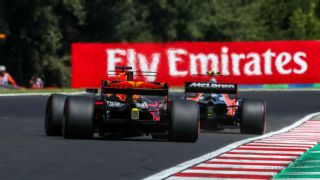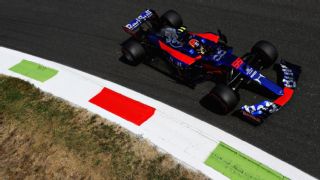|
The end of McLaren and Honda's disastrous Formula One partnership appears to be imminent. The future of McLaren's relationship with Honda has been in doubt for much of this season, the third consecutive year the Japanese manufacturer has delivered its partner an uncompetitive and unreliable power unit. McLaren ended a long affiliation with Mercedes power to rekindle its partnership with Honda in 2015, which both parties hoped could replicate its dominant years of the late 1980s and early 1990s. Instead in two and a half years McLaren has finished ninth and sixth in the constructors' championship, and lies ninth in this year's standings, with just seven top-six race finishes in that time. Multiple reports suggest the divorce is likely to be confirmed in the coming days, with the F1 paddock currently travelling to Asia for the Singapore Grand Prix. That news is expected to trigger a series of changes, with McLaren and current Renault customer Toro Rosso set to swap engine suppliers for 2018. In exchange for ending its Toro Rosso contract with Renault early, Red Bull is due to release Carlos Sainz from his contract to join the French manufacturer's factory team. Reasons for the McLaren-Honda split  After a difficult first two years, the scrapping of the restrictive engine development token system for 2017 -- which had previously prevented manufacturers making radical changes to engine concepts -- raised hopes Honda could dramatically cut the gap to Merceces this year. Honda re-packaged its engine for the new season but still found itself a distant fourth (out of four suppliers) in the pecking order at the season-opening Australian Grand Prix. McLaren has made no secret of its dissatisfaction this year and there were suggestions the team would go back to Mercedes, though neither the world champions nor Ferrari were interested in offering an engine supply. But simply splitting from Honda has proved to be problematic, with Honda reluctant to end the partnership prematurely and Formula One bosses keen to keep the Japanese company in the sport. Without Honda finding itself another team it seemed unlikely McLaren could go ahead with its separation -- which is where Toro Rosso came in. A switch would mean McLaren abandoning a fully-fledged factory partnership with Honda to join Red Bull as a Renault customer. That represents an ironic about-turn for the team, with former CEO Ron Dennis originally signing the Honda deal due to his belief that F1's current engine regulations make it impossible for a customer team to win a championship.  It means Toro Rosso will go from being the clear third choice in the Renault pecking order to the main focus of Honda's F1 resources. For Red Bull there is an obvious benefit in its junior team taking Honda power, as it allows the Japanese manufacturer to sort out its problems away from the spotlight of one of the grid's 'Big Four'. If it does become competitive, Red Bull, dissatisfied with Renault since the start of the V6 turbo era, would likely become Honda's factory partner. Away from poor performance and reliability, other issues have undoubtedly fuelled McLaren's desire to seek an early end to the Honda deal. The first, and most obvious, is the future of star driver Fernando Alonso, who has spent three miserable seasons languishing a long way off the pace. The Spaniard, widely considered the most complete driver on the current grid, has spent much of that time seemingly out-performing the car's he's been given and this year was allowed to miss the Monaco Grand Prix to contest the Indy 500 in a McLaren-Honda/Andretti Autosport car -- seen by some as a sweetener from McLaren boss Zak Brown to convince the Spaniard to remain with the team long-term.  But Alonso's adventure at Indy ended with a Honda engine failure in the closing laps while he still had an outside shot at victory, a moment which appeared to trigger a change in tone from Brown about the viability of the partnership beyond 2017. Brown came into his role as executive director last year promising to complete McLaren's search for a title sponsor -- something it has not had since the end of its Vodafone deal in 2012. McLaren-Honda's results in the early and middle stages of this season are unlikely to have convinced Brown a big-name sponsor can be found by 2018, when the American had declared the team "need to deliver" a title partner. Incidents in the weeks after the Indy 500 appeared to place further strain on the partnership, with Honda missing scheduled upgrades planned for Canada and Belgium. At the latter, Honda arrived not with its Spec 4 engine as expected but with upgrades it labelled Spec 3.5 and 3.6. Despite making clear steps forward in performance, it appeared to be too little too late to convince McLaren not to end the partnership early. Sainz becomes Renault's bargaining chip Renault's decision to accept McLaren and free up Toro Rosso to go to Honda appears to have come at a price. The French manufacturer is unlikely to retain Jolyon Palmer beyond 2017 and, according to Motorsport.com, wanted an incentive to switch its supply from Toro Rosso to McLaren. That incentive appears to be Sainz, who looks set to join the team in exchange for Renault allowing Toro Rosso out of its contract without a fuss. Renault was known to be interested in Sainz's services last season but found Red Bull unwilling to budge on the Spaniard's contract. The highly-rated Spaniard had appeared to be stuck in a difficult situation at Toro Rosso, with Daniel Ricciardo and Max Verstappen blocking his only contractually available step up the grid at Red Bull. As for Alonso, McLaren's switch to Renault power is likely to keep him with the team. He had denied making McLaren a 'Honda or me' ultimatum but in recent months has dropped numerous hints that the choice the team had to make to keep him was "simple". With several possible destinations on IndyCar's 2018 grid also closing up in recent days the Spaniard looks set to be back in a Renault-powered car next year for the first time since 2009.
|
